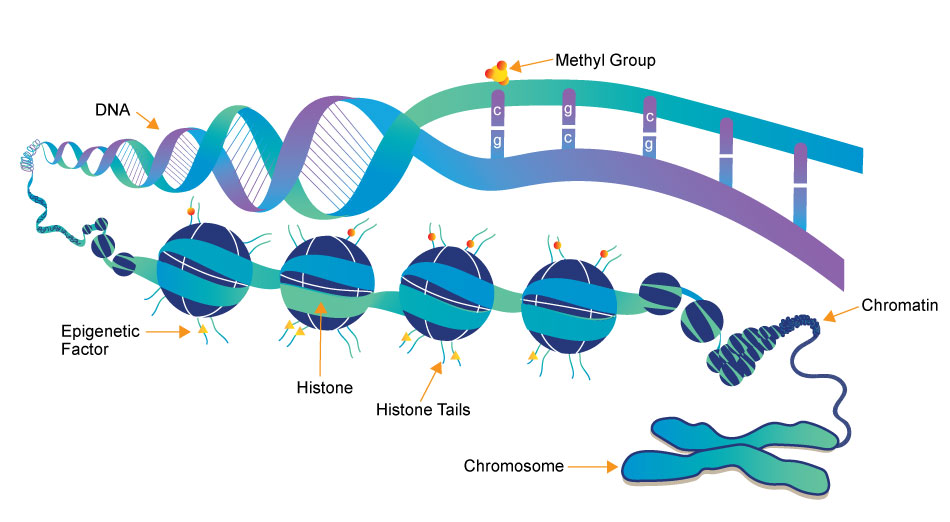Epigenetics


Epigenetics research delves into the molecular mechanisms that control gene expression and cellular traits without altering the underlying DNA sequence. One crucial aspect of this field is the role of small molecules, which act as powerful regulators of epigenetic modifications. These small compounds, typically comprising a few dozen to a few hundred atoms, have emerged as essential tools in understanding and manipulating the epigenome.
- DNA Methylation Inhibitors: Small molecules like 5-azacytidine and 5-aza-2'-deoxycytidine are DNA methyltransferase inhibitors. They block the addition of methyl groups to DNA, leading to DNA demethylation. This can reactivate silenced genes, potentially offering therapeutic avenues for conditions like cancer.
- HDAC inhibitors: HDACs remove acetyl groups from histone proteins, contributing to gene repression. Small molecule HDAC inhibitors, such as Vorinostat and Romidepsin, can reverse this process by increasing histone acetylation, allowing genes to be more accessible for transcription. These inhibitors are being explored for cancer therapy and other conditions.
- Histone Methyltransferase Inhibitors: Small molecules like GSK126 inhibit specific histone methyltransferases, affecting histone methylation patterns. This can alter gene expression, making them promising candidates for cancer and other diseases with epigenetic dysregulation.
- RNA Modulators: Small molecules can also target non-coding RNAs involved in epigenetic regulation. For instance, small molecules called small interfering RNAs (siRNAs) can be designed to target and degrade specific long non-coding RNAs, influencing gene expression.
- Epigenetic Reader Domain Inhibitors: These small molecules target proteins that recognize and bind to specific epigenetic marks. Examples include inhibitors of bromodomain-containing proteins (BET inhibitors), which can disrupt gene regulation by interfering with protein-DNA interactions.
Small molecules in epigenetics research not only provide insights into the fundamental biology of gene regulation but also hold immense promise for developing novel therapeutics. Their ability to selectively modulate specific epigenetic marks and pathways has led to ongoing clinical trials and drug development efforts for various diseases, including cancer, neurological disorders, and inflammatory conditions. Understanding and harnessing the power of these small molecules is at the forefront of modern epigenetics research, offering new hope for precision medicine and targeted therapies.
3 key components involved in the regulation of epigenetic modifications
Epigenetics Writer
Epigenetics writers are enzymes responsible for adding chemical marks or modifications to DNA or histone proteins. These marks include DNA methylation (addition of methyl groups to DNA) and histone modifications (such as acetylation, methylation, phosphorylation, etc.).
Epigenetics Reader
Function: Epigenetics readers are proteins that can recognize and bind to specific epigenetic marks on DNA or histones. These reader proteins interpret the epigenetic code and facilitate downstream cellular processes, such as gene activation or repression.
Epigenetics Eraser
Function: Epigenetics erasers are enzymes responsible for removing or reversing epigenetic marks on DNA or histones. This process allows for the dynamic regulation of gene expression and the resetting of epigenetic states during various stages of development and in response to environmental changes.
-
HDAC6 抑制剂
ACY-241 是一种新型、选择性的、可口服的 HDAC6 抑制剂。- Bae J, .et al. , Leukemia, 2018, Sep;32(9):1932-1947 PMID: 29487385
-
SUV39H HMT 抑制剂
Chaetocin 是一种组蛋白甲基转移酶 SUV39H1 抑制剂(IC50 = 0.8 μM)。在体外能诱导多发性骨髓瘤细胞系发生凋亡;在体内小鼠多发性骨髓瘤模型中表现出抗增殖活性。- Linna Han, .et al. , Biochem J, 2023, Mar 31;480(6):421-432 PMID: 36896918
-
p300/CBP 抑制剂
C646 是一种选择性的 p300/CREB结合蛋白(CBP)抑制剂(Ki = 400 nM)。- Thibaud Reyser, .et al. , Pharmaceutics, 2023, Oct 10;15(10):2440 PMID: 37896200
- Zhifeng Zhang, .et al. , PLoS One, 2017, 12(10): e0186900 PMID: 29049411
-
Pdia3/ERp57 activator, STAT3 抑制剂
Diosgenin glucoside,一种从Tritulus terrestris L. 提取的皂苷化合物,通过调节小胶质细胞 M1 极化提供神经保护。Diosgenin glucoside 通过调节自噬和减轻凋亡来保护脊髓损伤。 -
plant growth regulator
Daminozide(DMASA;DIMG;B 995),一种植物生长调节剂,选择性地抑制 KDM2/7 JmjC 亚家族。 -
Histone demethylase 抑制剂
GSK J1 是一种强效且选择性的 H3K27 组蛋白去甲基化酶 JMJD3 和 UTX 的抑制剂。- Nicolas A Fraunhoffer, .et al. , EBioMedicine, 2023, Jun;92:104602 PMID: 37148583
- Guang Bai, .et al. , Epigenetics of Chronic Pain, 2019, Pages 1-48
-
Menin-MLL interaction 抑制剂
MI-2(Menin-MLL 抑制剂 2)能特异性地结合到 Menin 并抑制 Menin 与细胞中 MLL 融合蛋白的相互作用。它可以通过下调 MLL 融合蛋白致癌活性下游的靶基因表达,有效逆转 MLL 融合蛋白介导的白血病转化。MI-2 是一个用于更好理解 MLL 介导的白血病发生的新工具,并代表了研究 Menin 作为 MLL 融合蛋白的致癌辅因子的新方法。 -
BET bromodomain 抑制剂
CPI203 是一种新型的强效、选择性且细胞渗透性的抑制剂,针对 溴结构域和额外末端 (BET) 家族蛋白 BRD4,在 BRD4 α-screen 测试中的 IC50 约为 37 nM。- Derenzini E, .et al. , Cell Rep, 2018, Aug 21;24(8):2155-2166 PMID: 30134175
-
JAK1 抑制剂
PF-03394197(奥克拉西替尼)是一种强效的JAK1抑制剂。- Steven E. Davison, .et al. , PLoS One, 2022, Oct 18;17(10):e0276333 PMID: 36256616
- Banovic F, .et al. , Vet Dermatol, 2018, Nov 12 PMID: 30417482
- Nicholas B, .et al. , J Allergy Clin Immunol, 2017, Jul;140(1):309-312.e4 PMID: 28259448
- Fukuyama T, .et al. , J Pharmacol Exp Ther., 2015, Sep;354(3):394-405 PMID: 26159873
-
EZH2 抑制剂
GSK343 是一种强效的组蛋白 H3-赖氨酸 27 (H3K27) 甲基转移酶 EZH2 抑制剂(IC50 = 4 nM)。对其他 HMTs 有1000倍的选择性,除了 EZH1(60倍选择性)。GSK343 在 HCC1806 细胞中抑制 H3K27 甲基化,IC50 <200nM(通过免疫荧光测定)。- Yang PM, .et al. , Am J Cancer Res, 2019, Oct 1;9(10):2120-2139 PMID: 31720078
- Nie L, .et al. , Nat Commun, 2019, Nov 8;10(1):5114 PMID: 31704972
-
Lin28-let-7a 拮抗剂
Lin28-let-7a antagonist 1 对 Lin28-let-7a 之间的相互作用表现出明显的拮抗效果,其 IC50 值为4.03 μM,针对 Lin28A-let-7a-1 的相互作用。 -
HDAC 抑制剂
RG2833 是一种能穿透大脑屏障的 HDAC 抑制剂,其 IC50 分别为 60 nM 和 50 nM,针对 HDAC1 和 HDAC3。 -
JAK1 抑制剂
GLPG0634 是一种口服可用的、选择性的 JAK1 (Janus kinase 1) 抑制剂,由 Galapagos 公司开发,用于治疗类风湿性关节炎以及可能的其他炎症性疾病。- Keisuke Nishimura, .et al. , Arthritis Rheumatol., 2015, Apr;67(4):893-902 PMID: 25545152
-
bromodomain 抑制剂
Bromosporine 是一种广谱的 bromodomains 抑制剂,其 IC50 分别为 BRD2 的 0.41 μM、BRD4 的 0.29 μM、BRD9 的 0.122 μM 和 CECR2 的 0.017 μM。 -
SMYD2 抑制剂
AZ505 ditrifluoroacetate 是一种强效且高度选择性的 SMYD2 抑制剂(IC50=0.12 uM),具有潜在的抗癌活性,其选择性是 SMYD3(IC50>83.3 uM)、DOT1L(IC50>83.3 uM)、EZH2(IC50>83.3 uM)的600倍以上。 - Trifloxystrobin(CGA 279202)是一种杀菌剂,对于大型溞幼体和胚胎,其48小时处理后的EC50分别为23.0微克/升和1.7微克/升。
-
pan-Pim kinase 抑制剂
AZD1208 是一种口服可用的小分子抑制剂,针对 PIM激酶,具有潜在的抗肿瘤活性。- Corbin C Jensen, .et al. , J Cell Biol, 2023, Jun 5;222(6):e202208136 PMID: 37042842
- Jeremiah J Bearss, .et al. , EMBO Rep, 2021, Apr 7;22(4):e50835 PMID: 33586867
- Remy J, .et al. , Biochim Biophys Acta Mol Cell Res, 2019, Feb;1866(2):175-189 PMID: 30389373
- Andrea L. Casillas, .et al. , Clin Cancer Res, 2018, Jan 1; 24(1): 169-180 PMID: 29084916
- Jin H. Song, .et al. , Mol Cancer Ther, 2018, Dec;17(12):2710-2721 PMID: 30190422
- Sathish K.R. Padi, .et al. , Oncotarget, 2017, May 2; 8(18): 30199-30216 PMID: 28415816
- Lim R, .et al. , Mol Hum Reprod, 2017, Jun 1;23(6):428-440 PMID: 28333279
-
HDAC3 抑制剂
RGFP966 是一种 HDAC3 抑制剂,IC50 为 0.08 μM,对其他 HDAC 的选择性超过 200 倍。- Vijaya Bharti, .et al. , Cell Rep, 2022, Dec 20;41(12):111826 PMID: 36543138
-
CBP/p300 bromodomain 抑制剂
SGC-CBP30 是一种强效且选择性的 CREBBP (CBP) 和 EP300 抑制剂,这两者是广泛的转录共激活因子。- Kevin Bohm, .et al. , Arch Pharm (Weinheim), 2023, Jul;356(7):e2200661 PMID: 37196427
-
human A3 adenosine receptor 拮抗剂 /Aurora 抑制剂
Reversine 是一种强效的人类 A3 腺苷受体拮抗剂,其 Ki 值为 0.66 μM,同时也是一种全泛 Aurora A/B/C 激酶抑制剂,其 IC50 分别为 12 nM、13 nM 和 20 nM。此外,Reversine 还用于干细胞去分化。- Amy H. Ide, .et al. , Mol Biol Cell, 2023, Jun 1;34(7):ar76 PMID: 37126397
- Hazheen K, .et al. , J Biol Chem, 2020, August 20
-
LSD1/BHC110 & MAO 抑制剂
Tranylcypromine hydrochloride 是一种非选择性 MAO-A/B 抑制剂。




